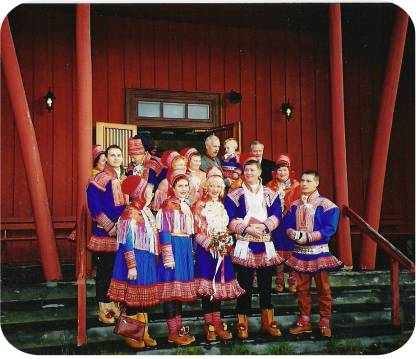|
 
People of Lapland.
Laplander celebration/wedding attire or costumes are depicted in the photo above.
Even though, the Samis, also called Laplanders, have their own language and culture. Lapland is not a nation, but is also part of Norway. Lapland is located above the Arctic Circle in Europe in the countries of Norway, Sweden, Finland and Russia. Lapland is the name given to the most northern parts of these countries where these gentle and talented Sami people live. In Norway, we refer to them as Same, pronounced, Saw-meh. Like most places, Norway has a mix of folks from many countries. The Laplanders believe they were the first to live in these northern lands. “Laps” or “Laplanders”. Some Laps live near the sea in order to fish
for their In Finland, many are fishermen; others are reindeer herders. Russian Laps herd reindeer during the winter and in summer move to the coast in order to fish. Some Norwegian Laplanders are wealthy with enormous reindeer herds. In the later years some Norwegian Laps have migrated to the cities and have regular jobs. More than half of the Swedish Laps are farmers or work in the forests; the rest wander with their reindeer. The Same population of Norway is about 20,000. The TV programs covers local news, pertaining to the "Lapland nation" and the areas where they live. On a recent trip to Norway, I watched a Sami news program with Norwegian subtitles, and it was very interesting. Among the things they spoke about was their recent problems with wolves. Languages The Sami language is one of Norway's four official, written languages. The Sami children in Norway attend regular schools and receive a complete education. Most Norwegian Laplanders speak Norwegian as their second language. They have television programs in their own language with Norwegian sub-titles. I speak Norwegian, but I can't understand one word of the Norwegian Sami language. It is a totally different than the Norwegian language. Sami is based on the Finnish language. Finnish is a weird language, it is not Scandinavian. Germanic nor Slavic. It is classified as a "Uralic" language along with Hungarian an Estonian. The Sami languages in Norway, Sweden, Finland, not in Russia, consist of 5 Western Finnish dialects, called the Peräpohjola Dialects. These diallects are called Tornio, Jällivaara, Kemi, Kemijärviand and Ruija. In Northen Finland, the Laplander speak the Tornio dialect. The Kemi dialect is spoken in Finland in the municipalities of Inari, Kemi, Kittilä, Rovaniemi, Simo, Sodankylä, Tervola and Utsjoki. The Kemijärvi dialect is spoken in Finland, namely in the areas of Kemijärvi, Pelkosenniemi, Salla and Savukoski. The Jällivaara dialect is spoken in Sweden, in the areas of Jällivaara, Killivaara and Nattavaara. In Sweden, the Tornio dialect, together with the Jällivaara dialect is called Meänkieli. Meänkieli has an official minority language status in Sweden. The Ruija dialect is spoken by the Laps in Northern Norway, that live mostly in the areas of Alta, Lyngen, Lakselv, Kvaenangen, Nordreisa and Vadsø. This dialect is called The Kven Language in Norway for political and historical reasons. Visit us often as more pages will be added about the people of Norway and the rest of Scandinavia as well as interesting facts about the Sami people. All Rights Reserved
|




